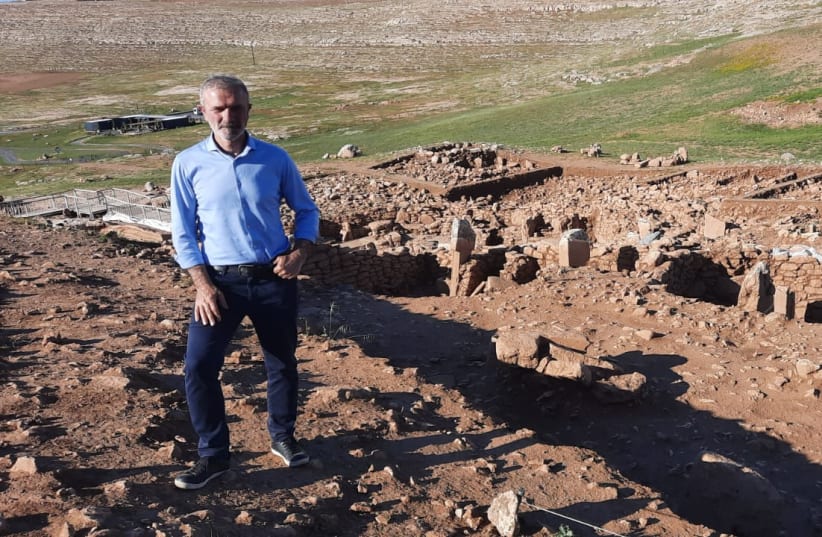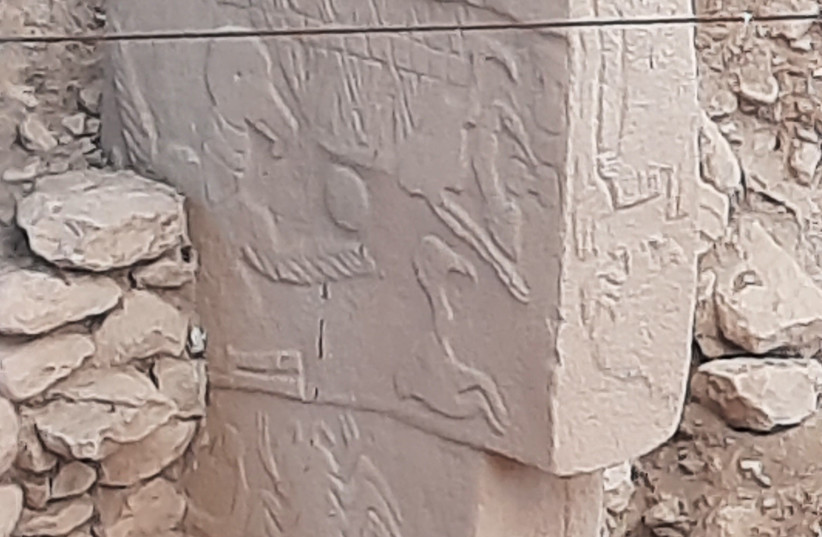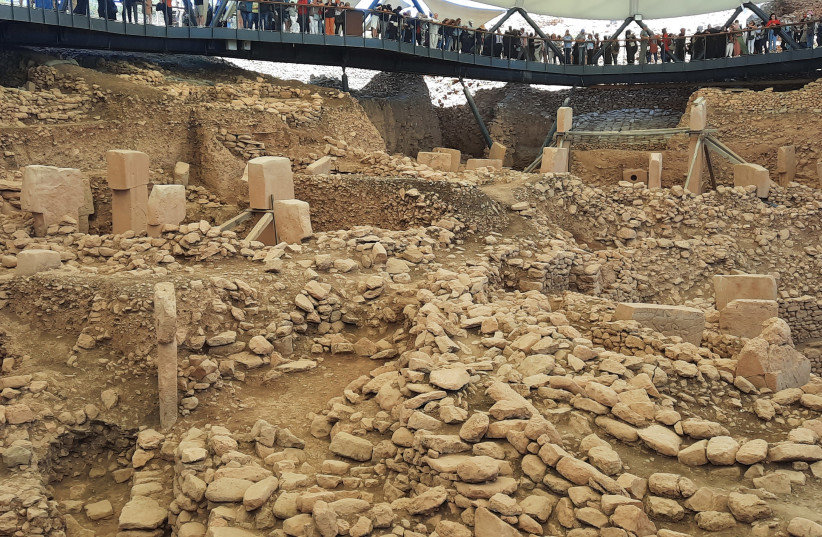Istanbul archaeology professor Necmi Karul picks his way as nimbly as a gazelle along the hilly back slope of Karahantepe. A monumental Neolithic site near the Syrian-Turkish border, Karahantepe has turned what archaeologists until now believed about the evolution of human sedentism on its head.
It, along with the nearby Gobeklitepe Stone Hill site, is considered one of the first permanent settlements. They have brought into question the process of organized human society, suggesting that it was established before the emergence of agriculture, and included some kind of cultic or communal rituals.
Karul points out spots where some 11,000 years ago Neolithic humans carved out huge blocks of limestone and somehow brought the heavy pillars to the other side of the mound. After being carved with images of animals and humans, these blocks were placed in concentric circles in what he calls “special buildings.”
Walking along the sloping hillside Karul also points at stones jutting out from the earth in a circular pattern. Underneath, he said casually, there are the same thousands-year-old monumental pillars that have been excavated just on the other side of the mound.
He said 250 such pillars visible on the surface have been identified, and some 60 pillars have been found in the excavations.
“Until recently we thought animal farming was the reason people became sedentary but now we see that was not the reason,” he said. “First they became sedentary and then came the animal domestication.”
Today the area is semi-arid, but looking out over the Harran plain where Karahantepe, or Karanhan Hill, is located it is not difficult to imagine the hunting scenes Karul describes, with woodland areas of wild oak, pistachio and walnut trees spreading out into the horizon and large wild goats and gazelles being corralled into one of the 28 traps found in the excavation and killed by early human hunters.
Agriculture
“It is difficult to pinpoint the exact time when humans began (sedentary) farming. Agriculture did not begin in one second, the same with animal farming,” said Karul. “It took some five to six centuries to domesticate animals. We can find different stages of this process in the excavation. We see evidence that they collected seeds.”
Even older evidence of collection of wild barley seeds in the Levant has also been found in what is today Israel, and Karul readily points out that these processes were taking place in different stages throughout the Fertile Crescent area. At the top of the Fertile Crescent, where Gobeklitepe and Karahantepe are part of a series of the over 12 Neolithic Taş Tepeler, or Stone Hills, under planned excavation, the meeting of two climate zones created new climatic conditions which allowed wild plants to propagate quicker, and so the numbers of animals increased and people no longer had to search for food far away, he said.
“People became sedentary not because of a lack of food sources but because of (an abundance) of sources,” he said. “There were animals up in the mountains of course, and also in the plain. It was a paradise.”
Most reports say there are 12 of these Taş Tepeler in the Anatolian and Upper Mesopotamian region spanning 200 kilometers, but Karul said there are more of these settlements all with “T” shaped obelisks in their special buildings.
“Some colleagues like to call Gobeklitepe a pilgrimage site but I don’t like to call it that,” he said.
Dwellings were also uncovered near the special buildings, and some with miniatures of the “T” shaped pillars, leading Karul to believe that rituals similar to the ones which took place in the communal buildings may have taken place in people’s homes as well.
Carbon-14 dating has placed the special buildings and the dwellings as contemporary structures, he said and their relative location to one another indicates that they were built with consideration of each other.
In addition, 27 large cisterns have been found at Karahantepe, some with the potential capacity of holding 100 tons of water. Some of these were still being used by people in the village at the foot of the mound until 10 years ago.
Excavations have already begun on eight of the Taş Tepeler sites, said Karul, and they are planning to begin with more excavations this summer together with an Italian team at three more: Sogutarlasi, Biris Mezarligl and Çakmaktepe.
Karul worked with the late German archaeologist Klaus Schmidt who began the excavations at Gobeklitepe in 1995 and is now managing the Göbeklitepe Culture and Karahantepe Research Project. In some circles, he is something of a minor celebrity.
As he arrived on a recent visit to Karahantepe, which has just recently opened to tourists, he was surrounded by a group of admirers from Istanbul who had completed their tour of the site and listened attentively as he good-naturedly answered their questions.
Despite its remote location in Southeastern Turkey, Gobeklitepe—where five special buildings have already been excavated—has become popular with internal tourists. The carved pillars exhibit intricate carvings of humans and animals including foxes, spiders, and flamingos. One scene shows a bald Ibis carrying off the head of a body below, in keeping with known burial practices of the time. Made before the use of metal tools, all the carvings were stone on stone and demonstrate artistic skill previously not believed to have been possible during the Neolithic period. The different artistic styles also suggest they were made by different people.
“I don’t think the big buildings were temples,” said Karul. “If you call them a temple you are underestimating their function. If you go into a temple you go to pray. But in this place, people came together. That does not always mean they came to pray. If you say it was only ritual then you get stuck in that mindset. I think they were multi-functional buildings.”
Relegating their use to only a spiritual function is dangerous, he said and comes from a modern mindset.
Karahantepe, which Karul tentatively dates to 11,500 BCE, is about two thousand years older than Gobeklitepe which is dated to around 9,600 BCE.
Interestingly, at both places the special buildings were in use for about 100 years and then buried with filling material when another structure was constructed, he said.
“Why was there an end? No one can answer that but with humans, there is always an end,” he said.
Though similar, Karul said the buildings in Gobeklitepe and Karahantepe, which cover about 10 hectares (100 acres), are of different styles and may contain clues about the beginning of religion. Both contain graves inside the special buildings. At both Gobeklitepe and Karahantepe, some of the carvings are complex three-dimensional sculptures including a man carrying a leopard from Gobeklitepe. In Karahantepe benches have been carved into the bedrock on one side of the special building, which has benches all the way around. As in all the special buildings two of the monumental pillars, some of which reached 20 meters in height, were placed facing each other in the middle, and other pillars formed concentric circles around them. The largest of the special buildings measures 23 meters in diameter and it is calculated to have been able to hold some 400 people.
This may have been the beginning of fashioning the hunter-gatherers into a cohesive community, he said.
“This could have been a gathering place where people came together to gossip and have discussions,” said Karul. “People talk about the building but the building is not important. What is important is what happened inside. Maybe they used the pillars as a blackboard to write stories. It shows they had a collective memory and the need for mythological stories, which have an important function of bringing people together to create an identity.”
After all, he said, this was a time when a new type of society was being created and may also have been the beginning of storytelling.
“You need storytellers, and artists and craftsmen to make such symbols on the pillars, people to organize all these rituals.”
Professor Necmi Karul
It is now also possible to begin talking about some sort of horizontal hierarchy in the society as well with people sharing knowledge.
In a small side room connected to the largest special building in Karahantepe, 17 phallus-shaped pillars were placed in a circle and on the wall above them, a snake with a three-dimensional human head with thick lips was carved all along the bedrock.
When standing in the room the eyes seem to follow whoever enters from the larger special building, said Karul.
“There was a bringing process into this room. It means these two places had a different meaning,” said Karul. Maybe, he said, it could have been some initiation into manhood.
Similar formations and structures have been found in many places, especially along the Mediterranean coast and also in the Levant, said Karul.
“People everywhere in the world (were doing similar things),” he said. “You don’t have to think along linear lines. Not everything continued. Some things stopped. We don’t know exactly if this Gobeklitepe culture continued.”
For now, there is not enough evidence of the ancestors of the culture to make any certain determinations about the structures, he said, which is why he believes it is necessary to concurrently excavate as many of the stone hills as possible as they each may help contribute to putting the pieces of the puzzle together.
The author was a guest of the Turkey Tourism Promotion & Development Agency


